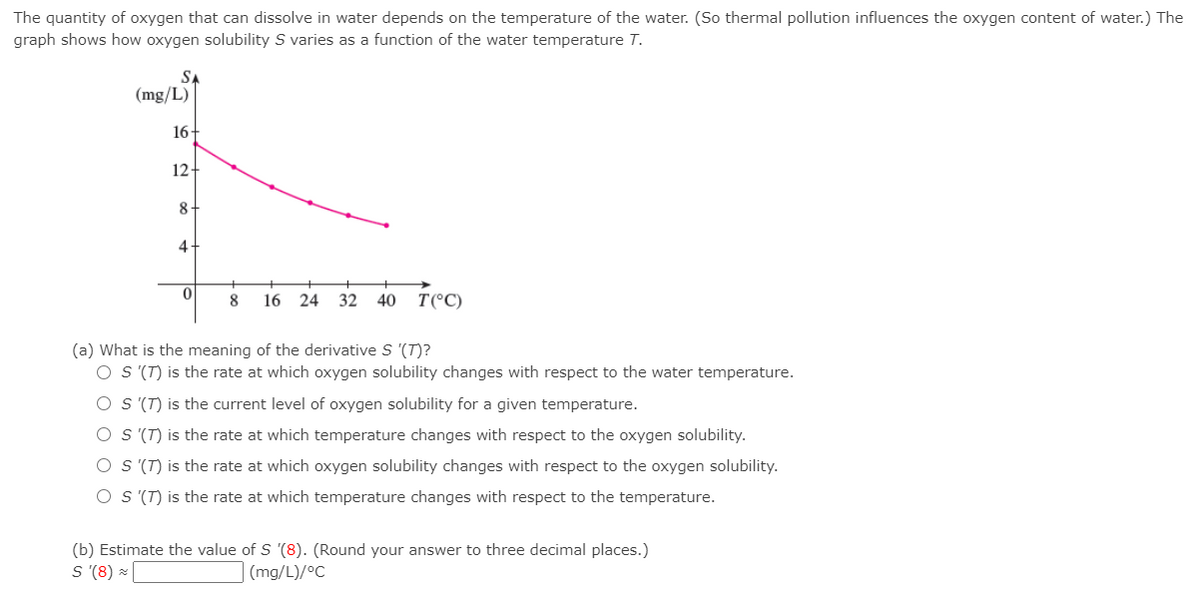The quantity of oxygen that can dissolve in water depends on the temperature of the water. (So thermal pollution influences the oxygen content of water.) The graph shows how oxygen solubility S varies as a function of the water temperature T. SA (mg/L) 16 12 8- 4 8 16 24 32 40 T(°C) (a) What is the meaning of the derivative S '(T)? O S (T) is the rate at which oxygen solubility changes with respect to the water temperature. O S (T) is the current level of oxygen solubility for a given temperature. O S (T) is the rate at which temperature changes with respect to the oxygen solubility. O S(T) is the rate at which oxygen solubility changes with respect to the oxygen solubility. O S (T) is the rate at which temperature changes with respect to the temperature. (b) Estimate the value of S (8). (Round your answer to three decimal places.) S (8) ×| (mg/L)/°C
The quantity of oxygen that can dissolve in water depends on the temperature of the water. (So thermal pollution influences the oxygen content of water.) The graph shows how oxygen solubility S varies as a function of the water temperature T. SA (mg/L) 16 12 8- 4 8 16 24 32 40 T(°C) (a) What is the meaning of the derivative S '(T)? O S (T) is the rate at which oxygen solubility changes with respect to the water temperature. O S (T) is the current level of oxygen solubility for a given temperature. O S (T) is the rate at which temperature changes with respect to the oxygen solubility. O S(T) is the rate at which oxygen solubility changes with respect to the oxygen solubility. O S (T) is the rate at which temperature changes with respect to the temperature. (b) Estimate the value of S (8). (Round your answer to three decimal places.) S (8) ×| (mg/L)/°C
Chemistry
10th Edition
ISBN:9781305957404
Author:Steven S. Zumdahl, Susan A. Zumdahl, Donald J. DeCoste
Publisher:Steven S. Zumdahl, Susan A. Zumdahl, Donald J. DeCoste
Chapter1: Chemical Foundations
Section: Chapter Questions
Problem 1RQ: Define and explain the differences between the following terms. a. law and theory b. theory and...
Related questions
Question
problem is attached!
i am completly stucked. please show work on how you solved problem so i can fully understand. thank you so much!

Transcribed Image Text:The quantity of oxygen that can dissolve in water depends on the temperature of the water. (So thermal pollution influences the oxygen content of water.) The
graph shows how oxygen solubility S varies as a function of the water temperature T.
SA
(mg/L)
16
12
4-
8
16
24
32
40
T(°C)
(a) What is the meaning of the derivative S '(T)?
O S (T) is the rate at which oxygen solubility changes with respect to the water temperature.
O S (T) is the current level of oxygen solubility for a given temperature.
O S (T) is the rate at which temperature changes with respect to the oxygen solubility.
O S (T) is the rate at which oxygen solubility changes with respect to the oxygen solubility.
O S (T) is the rate at which temperature changes with respect to the temperature.
(b) Estimate the value of S (8). (Round your answer to three decimal places.)
S (8) × |
(mg/L)/°C
Expert Solution
This question has been solved!
Explore an expertly crafted, step-by-step solution for a thorough understanding of key concepts.
This is a popular solution!
Trending now
This is a popular solution!
Step by step
Solved in 2 steps with 2 images

Knowledge Booster
Learn more about
Need a deep-dive on the concept behind this application? Look no further. Learn more about this topic, chemistry and related others by exploring similar questions and additional content below.Recommended textbooks for you

Chemistry
Chemistry
ISBN:
9781305957404
Author:
Steven S. Zumdahl, Susan A. Zumdahl, Donald J. DeCoste
Publisher:
Cengage Learning

Chemistry
Chemistry
ISBN:
9781259911156
Author:
Raymond Chang Dr., Jason Overby Professor
Publisher:
McGraw-Hill Education

Principles of Instrumental Analysis
Chemistry
ISBN:
9781305577213
Author:
Douglas A. Skoog, F. James Holler, Stanley R. Crouch
Publisher:
Cengage Learning

Chemistry
Chemistry
ISBN:
9781305957404
Author:
Steven S. Zumdahl, Susan A. Zumdahl, Donald J. DeCoste
Publisher:
Cengage Learning

Chemistry
Chemistry
ISBN:
9781259911156
Author:
Raymond Chang Dr., Jason Overby Professor
Publisher:
McGraw-Hill Education

Principles of Instrumental Analysis
Chemistry
ISBN:
9781305577213
Author:
Douglas A. Skoog, F. James Holler, Stanley R. Crouch
Publisher:
Cengage Learning

Organic Chemistry
Chemistry
ISBN:
9780078021558
Author:
Janice Gorzynski Smith Dr.
Publisher:
McGraw-Hill Education

Chemistry: Principles and Reactions
Chemistry
ISBN:
9781305079373
Author:
William L. Masterton, Cecile N. Hurley
Publisher:
Cengage Learning

Elementary Principles of Chemical Processes, Bind…
Chemistry
ISBN:
9781118431221
Author:
Richard M. Felder, Ronald W. Rousseau, Lisa G. Bullard
Publisher:
WILEY